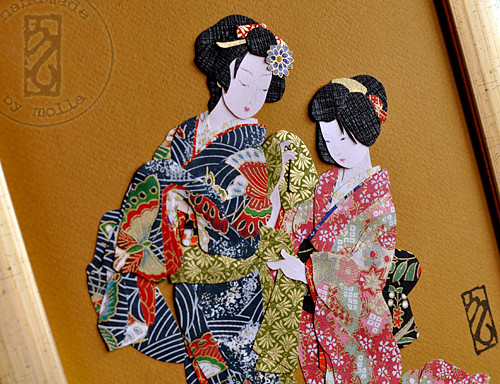To byla spontaniczna i dość nonszalancka przymiarka mojego nowego kimona, które kupiłam dobre pół roku temu. Całe lato o nim myslałam, ale ta pora roku nie sprzyja zakładaniu awase, czyli kimona na podszewce.
Zachwycona jestem delikatnością rysunku ptaszków "uguisu" wśród kwitnących kamelii, piekielne zdjęcia nie oddają w ogóle kolorów, na tych zdjęciach tło jest bladoróżowe:( Tylko ostatnie zdjęcie, nieco zbliża się do oryginału.
Ptaszki mają wyhaftowane oczy i dzioby.
To dziwne, bo po raz pierwszy nie jestem w ogóle pewna, czy kimono jest z prawdziwego czy sztucznego jedwabiu. Pięknie się układa, jedynym problemem jest to że jest przeznaczone dla osoby o wiele wyższej ode mnie. Ułożenie ładnego, chludnego ohashiori to sztuka nie lada.
It was a spontaneous and quite nonchalant trying on my new kimono that I bought a good half a year ago. I thought about it all summer, but this time of year is not great time to puting awase, a kimono with a lining.
I am delighted with the delicacy of drawing Uguisu birds among blooming camelia, hellish pictures do reflect real colors not at all, in these pictures the background is pale pink :( Only the last picture is a little closer to the original.
Birds have embroidered eyes and beaks.
It's strange, first time I'm not sure if kimono is a real or artificial silk. But the only problem is that it is designed for people with a lot higher than me. Laying nice, neat ohashiori it great job.
Zachwycona jestem delikatnością rysunku ptaszków "uguisu" wśród kwitnących kamelii, piekielne zdjęcia nie oddają w ogóle kolorów, na tych zdjęciach tło jest bladoróżowe:( Tylko ostatnie zdjęcie, nieco zbliża się do oryginału.
Ptaszki mają wyhaftowane oczy i dzioby.
To dziwne, bo po raz pierwszy nie jestem w ogóle pewna, czy kimono jest z prawdziwego czy sztucznego jedwabiu. Pięknie się układa, jedynym problemem jest to że jest przeznaczone dla osoby o wiele wyższej ode mnie. Ułożenie ładnego, chludnego ohashiori to sztuka nie lada.
It was a spontaneous and quite nonchalant trying on my new kimono that I bought a good half a year ago. I thought about it all summer, but this time of year is not great time to puting awase, a kimono with a lining.
I am delighted with the delicacy of drawing Uguisu birds among blooming camelia, hellish pictures do reflect real colors not at all, in these pictures the background is pale pink :( Only the last picture is a little closer to the original.
Birds have embroidered eyes and beaks.
It's strange, first time I'm not sure if kimono is a real or artificial silk. But the only problem is that it is designed for people with a lot higher than me. Laying nice, neat ohashiori it great job.



















































